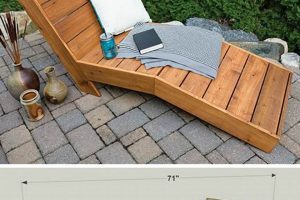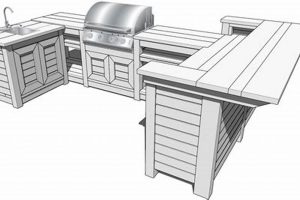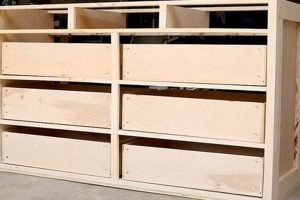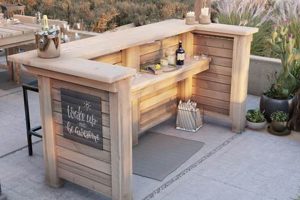Instructions for constructing shelving units independently are readily available. These instructions can range from simple guides detailing the assembly of basic structures to complex blueprints involving intricate designs and advanced carpentry techniques. One example is a set of instructions outlining the creation of a floating shelf using readily accessible materials and minimal tools.
The value of self-directed shelving construction lies in its economy, customizability, and potential for skill development. Creating storage solutions independently allows for cost savings compared to purchasing pre-made furniture. The ability to tailor dimensions, materials, and style to specific spatial and aesthetic requirements offers a high degree of personalization. Historically, the practice represents a continuation of self-sufficiency traditions, adapted to contemporary needs and readily accessible information.
Therefore, a thorough examination of the resources, considerations, and techniques associated with creating individualized storage solutions is warranted. This includes investigating material selection, tool requirements, construction methodologies, and safety protocols necessary for successful project completion.
Guidance for Self-Directed Shelving Construction
The following provides key considerations for undertaking independent shelving projects, emphasizing practical strategies and safety measures for successful outcomes.
Tip 1: Assess Load Requirements: Before commencing construction, determine the intended weight capacity of the shelf. Factor in a safety margin to prevent structural failure. For instance, a bookshelf intended for heavy volumes requires thicker materials and more robust support than a shelf for lightweight decorative items.
Tip 2: Select Appropriate Materials: Material choice impacts both aesthetics and structural integrity. Solid wood offers strength and aesthetic appeal but may be more expensive. Engineered wood products, such as plywood or MDF, offer cost-effectiveness and stability. Consider material resistance to moisture and insect damage based on the environment.
Tip 3: Ensure Accurate Measurements: Precision is paramount. Utilize a reliable measuring tape and level to ensure accurate cuts and proper alignment. Inaccurate measurements can lead to instability and necessitate costly rework.
Tip 4: Prioritize Secure Fasteners: Select fasteners appropriate for the materials being joined and the anticipated load. Screws generally provide superior holding power compared to nails. Use wood glue in conjunction with fasteners for enhanced joint strength.
Tip 5: Apply Appropriate Finishes: Apply a protective finish to enhance durability and appearance. Consider factors such as moisture resistance, scratch resistance, and UV protection. Select a finish compatible with the chosen material. Follow manufacturer instructions for application.
Tip 6: Adhere to Safety Protocols: Always wear appropriate safety gear, including eye protection, gloves, and respiratory protection, when cutting, sanding, or applying finishes. Work in a well-ventilated area. Secure workpieces to prevent movement during cutting and assembly.
Tip 7: Verify Level Installation: Use a level during installation to ensure shelves are perfectly horizontal. Uneven shelves can cause items to slide off and indicate structural weaknesses. Shims can be used to correct minor discrepancies.
Careful planning, meticulous execution, and adherence to safety guidelines are essential for successful self-directed shelving construction. These considerations contribute to functional, aesthetically pleasing, and structurally sound storage solutions.
This guidance serves as a foundation for understanding key aspects of creating individualized storage solutions.
1. Dimensional Accuracy
Dimensional accuracy, in the context of self-directed shelving construction, represents a foundational element critical to the structural integrity and aesthetic appeal of the finished product. The relationship between precise measurements and successful execution is direct and consequential; deviations from intended dimensions can lead to instability, misalignment, and functional deficiencies. For instance, inaccurate cuts during the fabrication of shelf supports will result in an uneven surface, compromising the shelf’s load-bearing capacity and potentially causing items to slide off. This underscores the importance of meticulous measurement and cutting techniques in achieving the desired outcome.
The practical significance of dimensional accuracy extends beyond mere structural stability. Precise dimensions contribute to the overall visual harmony and professional appearance of the shelving unit. Consider a multi-tiered shelving system: even minor discrepancies in shelf spacing or board lengths become visually amplified, detracting from the intended aesthetic. Furthermore, accurate dimensions ensure compatibility with other components, such as drawers or doors, that may be integrated into the shelving design. Proper planning, including detailed sketches and cut lists, is essential for minimizing errors and ensuring that each piece aligns with the overall design specifications. Utilizing precision measuring tools, such as digital levels and accurate measuring tapes, further enhances the likelihood of achieving the required level of accuracy.
In summary, dimensional accuracy forms a cornerstone of successful shelving projects. Neglecting this aspect increases the risk of structural flaws, aesthetic compromises, and functional limitations. Prioritizing precision during the measurement, cutting, and assembly phases is crucial for creating durable, visually appealing, and functionally effective shelving solutions. The understanding and application of accurate dimensional control represent a primary determinant of project success in the realm of independent shelving construction.
2. Material Selection
Material selection stands as a pivotal decision point in the execution of independent shelving projects. The choice of material directly influences structural integrity, aesthetic properties, and overall longevity of the shelving unit. Understanding the nuances of various materials is, therefore, crucial for achieving desired outcomes.
- Load-Bearing Capacity and Material Strength
Different materials exhibit varying degrees of strength, directly affecting their ability to support weight. Solid hardwoods, such as oak or maple, offer superior load-bearing capacity compared to engineered wood products like particleboard. Choosing a material appropriate for the anticipated weight of items to be stored prevents structural failure. In a library shelving project intended for heavy volumes, solid wood is preferable, whereas lighter materials may suffice for decorative displays.
- Aesthetic Considerations and Visual Harmony
Material selection significantly contributes to the overall aesthetic of the shelving unit and its integration with the surrounding environment. The inherent color, grain pattern, and texture of the material define its visual characteristics. For example, reclaimed wood introduces a rustic aesthetic, while painted MDF provides a clean, contemporary look. Coordinating the material with existing dcor and personal preferences is crucial for achieving visual harmony.
- Durability and Environmental Factors
Material durability dictates the shelving unit’s resistance to wear, moisture, and other environmental factors. Solid wood generally offers greater longevity than engineered wood, particularly in humid environments. Considering the intended location of the shelving unit and potential exposure to environmental stressors is paramount. Outdoor shelving requires weather-resistant materials like cedar or treated lumber.
- Cost-Effectiveness and Budgetary Constraints
Material costs vary significantly, influencing the overall project budget. Solid hardwoods typically represent a more expensive option compared to engineered wood products. Balancing material quality with budgetary limitations is essential. Exploring cost-effective alternatives, such as using reclaimed wood or repurposing existing materials, can offer viable solutions without compromising structural integrity or aesthetic appeal.
The interconnectedness of these facets underscores the critical role of informed material selection in self-directed shelving projects. Considering load-bearing requirements, aesthetic preferences, durability concerns, and budgetary constraints facilitates the selection of the most appropriate material for each specific application, contributing to functional, aesthetically pleasing, and durable shelving solutions.
3. Structural Support
Structural support constitutes a critical element within the realm of independent shelving construction. Its primary function is to ensure the stability and load-bearing capacity of the shelving unit. Inadequate support mechanisms directly correlate with potential structural failure, leading to collapse or deformation under load. The absence of sufficient reinforcement exemplifies this cause-and-effect relationship. For instance, a long shelf made of thin plywood, lacking intermediate support, will exhibit significant sagging, rendering it unsuitable for storing heavier items. Therefore, appropriate structural considerations form an indispensable component of any well-executed shelving design.
The practical application of structural support principles manifests in various forms, including the strategic placement of vertical supports, the incorporation of bracing elements, and the selection of materials with inherent strength. Vertical supports, such as side panels or legs, bear the primary weight of the shelving unit. Bracing, often implemented through diagonal supports or a solid back panel, prevents racking and ensures stability. Material selection, as previously discussed, also plays a crucial role. Hardwoods, known for their high tensile strength, can be utilized for shelves intended to bear substantial weight. Furthermore, understanding load distribution is crucial; evenly distributing weight across the shelf minimizes stress on any single point, reducing the risk of localized failure.
In conclusion, structural support is fundamentally interwoven with the success of independent shelving projects. Ignoring this aspect inevitably results in compromised stability and reduced lifespan of the shelving unit. The principles of load distribution, material selection, and bracing techniques directly contribute to a robust and functional structure. A thorough understanding of these concepts enables the creation of shelving solutions capable of safely and reliably accommodating intended loads, while also ensuring long-term durability. Challenges in this area often stem from underestimating weight or improper joint construction, underscoring the need for careful planning and precise execution in all phases of the project.
4. Joint Strength
Joint strength, in the context of self-directed shelving construction, represents a critical determinant of the shelving unit’s overall structural integrity and longevity. The efficacy of any shelving project hinges upon the ability of its joints to withstand the intended loads and stresses. Insufficient joint strength invariably leads to structural failure, manifested as sagging, warping, or complete collapse. An example illustrates this relationship: a bookshelf constructed with simple butt joints, relying solely on fasteners without adhesive or mechanical interlocking, is prone to failure under the weight of multiple books. The absence of robust joinery compromises the entire structure’s ability to bear weight effectively.
Various joint construction techniques offer differing levels of strength and suitability for shelving applications. Dovetail joints, for instance, provide superior resistance to tensile forces due to their interlocking design. Mortise and tenon joints, characterized by a projecting tenon fitting into a mortise, offer exceptional shear strength. Conversely, simple butt joints, while easy to execute, lack inherent strength and require reinforcement through fasteners and adhesives. Selection of the appropriate joint type depends upon factors such as the anticipated load, material properties, and aesthetic considerations. For instance, shelves intended to support heavy items necessitate robust joint construction techniques, while decorative shelves may suffice with simpler joinery methods.
In summary, joint strength forms an indispensable element in independent shelving endeavors. Inadequate joint construction undermines the shelving unit’s stability and durability. Selecting appropriate joint types, employing proper construction techniques, and using suitable adhesives are paramount for creating structurally sound and long-lasting shelving solutions. Addressing potential weaknesses in joinery represents a proactive approach to mitigating the risk of structural failure and ensuring the satisfactory performance of the finished product. Understanding the nuances of joint construction facilitates informed decision-making and contributes to successful project outcomes.
5. Load Capacity
Load capacity is a paramount consideration in the realm of self-directed shelving construction. The maximum weight a shelf can safely bear is a direct function of design, materials, and construction techniques. Understanding and accurately calculating load capacity mitigates the risk of structural failure and potential damage to both the shelving unit and stored items.
- Material Properties and Weight Distribution
The inherent strength of the chosen material directly impacts load capacity. Different materials exhibit varying degrees of resistance to bending and deformation under weight. Solid hardwoods possess greater load-bearing capabilities compared to engineered wood products. Further, load distribution across the shelf’s surface influences its ability to bear weight. Concentrated loads place undue stress on specific areas, potentially leading to localized failure. Even distribution is vital.
- Span Length and Support Structure
The distance between supporting elements, known as the span length, inversely affects load capacity. Longer spans necessitate stronger materials or the incorporation of additional support structures to prevent sagging. Intermediate supports, such as vertical dividers or strategically placed brackets, effectively reduce the span length, enhancing the shelf’s ability to bear weight. The relationship between span length and load capacity is governed by principles of structural mechanics.
- Fastener Selection and Joint Strength
The choice of fasteners and the integrity of the joints connecting the shelving components play a crucial role in load capacity. Inadequate fasteners or poorly constructed joints constitute weak points in the structure, compromising its ability to withstand weight. Screws generally provide superior holding power compared to nails. Robust joinery techniques, such as mortise and tenon or dovetail joints, offer enhanced resistance to shear and tensile forces, thereby increasing the overall load capacity of the shelving unit.
- Safety Factors and Environmental Considerations
Incorporating a safety factor when calculating load capacity provides a margin of error to account for unforeseen circumstances or variations in material properties. This involves designing the shelf to withstand a weight significantly greater than the anticipated maximum load. Environmental factors, such as humidity and temperature fluctuations, can also affect material strength over time. Shelving units exposed to extreme environmental conditions may require additional reinforcement or the selection of more durable materials.
The interdependence of these elements highlights the necessity for meticulous planning and execution in self-directed shelving projects. Ignoring load capacity considerations introduces a significant risk of structural failure. Accurate calculations, appropriate material selection, and robust construction techniques are essential for creating safe and functional shelving solutions tailored to specific storage needs.
6. Finishing Techniques
Finishing techniques represent an integral and often underestimated component of self-directed shelving construction. These techniques encompass the processes applied to the shelving unit after its assembly, serving to enhance its aesthetic appeal, durability, and resistance to environmental factors. Neglecting appropriate finishing can diminish the lifespan of a shelving unit and detract from its visual impact. For example, unfinished wood is susceptible to moisture absorption, leading to warping and cracking. Similarly, a poorly applied finish can result in an uneven or unattractive surface. The choice of finishing technique is therefore inextricably linked to the overall success of independent shelving projects.
The practical application of finishing techniques varies according to the materials used and the desired aesthetic outcome. Staining, for instance, enhances the natural grain patterns of wood, adding depth and character. Painting provides a uniform color and offers greater protection against moisture. Applying a sealant, such as varnish or polyurethane, creates a protective barrier against scratches, stains, and UV damage. Selecting the appropriate finishing technique requires careful consideration of the intended use of the shelving unit and the specific properties of the chosen materials. A bookshelf in a humid environment benefits from a moisture-resistant sealant, while a decorative shelf may prioritize aesthetic appeal over durability. Furthermore, proper surface preparation is crucial for optimal adhesion and a smooth, even finish. Sanding, priming, and cleaning the surface before applying the finish ensures a professional-looking result.
In summary, finishing techniques are an essential consideration in independent shelving construction, impacting both functionality and aesthetics. The selection of appropriate techniques, coupled with meticulous execution, significantly enhances the longevity and visual appeal of the finished product. Overlooking this aspect can lead to premature deterioration and a compromised aesthetic outcome. Therefore, understanding and implementing proper finishing techniques contributes significantly to the overall success and lasting value of self-directed shelving projects.
7. Installation Precision
Installation precision directly influences the structural integrity and functional utility of any self-constructed shelving unit. The accuracy with which a shelving unit is installed determines its stability, load-bearing capacity, and long-term durability. Deviations from level or plumb, arising from imprecise installation, can induce uneven weight distribution, potentially leading to structural stress and eventual failure. Consider a bookshelf where one side is slightly higher than the other; this induces a torque that weakens joints over time and makes the shelf less suitable for its intended purpose. Successful execution of self-directed shelving projects necessitates prioritizing installation accuracy.
Ensuring precise installation requires meticulous attention to detail and the utilization of appropriate tools. A spirit level is indispensable for verifying that shelves are horizontally aligned, while a plumb bob or laser level confirms vertical alignment. Anchoring the shelving unit securely to wall studs, when applicable, enhances its stability and prevents tipping, particularly critical for taller units or those intended to store heavy objects. The type of wall anchors used must correspond to the wall material (e.g., drywall, plaster, concrete) to ensure adequate holding power. Moreover, proper spacing between shelves must be considered, taking into account the dimensions of items to be stored. The integration of these steps constitutes the foundation of precise installation.
In summation, installation precision is not merely an ancillary consideration but a fundamental element of successful self-directed shelving construction. Imprecise installation compromises the structural integrity and functional utility of the shelving unit. Prioritizing accuracy during the installation phase through meticulous measurement, the use of appropriate tools, and secure anchoring is essential for creating durable, stable, and long-lasting storage solutions. Effective implementation of these practices mitigates the risk of structural failure and ensures that the shelving unit fulfills its intended purpose reliably.
Frequently Asked Questions
The following addresses common queries and misconceptions regarding independent shelving projects, offering clarification and guidance to promote successful outcomes.
Question 1: What is the recommended material for shelves intended to support heavy books?
Solid hardwoods, such as oak or maple, are generally recommended due to their superior load-bearing capacity and resistance to bending. Engineered wood products, while more affordable, may require additional support or a thicker profile to achieve comparable strength.
Question 2: How can sagging be prevented in long shelves?
Sagging can be minimized by reducing the span length between supports, using thicker materials, or incorporating a center support. A back panel affixed securely to the frame can also provide additional rigidity and prevent sagging.
Question 3: What type of joint is most appropriate for shelves that will bear significant weight?
Mortise and tenon joints or dovetail joints offer exceptional strength and are well-suited for heavy-duty applications. These joints provide superior resistance to shear and tensile forces compared to simpler butt joints.
Question 4: Is it necessary to anchor shelving units to the wall?
Anchoring shelving units to wall studs is strongly recommended, especially for tall units or those intended to store heavy items. This prevents tipping and significantly enhances stability, reducing the risk of accidents.
Question 5: What safety precautions should be taken when working with power tools during shelving construction?
Appropriate safety gear, including eye protection, gloves, and respiratory protection, should always be worn. Work in a well-ventilated area and ensure workpieces are securely clamped to prevent movement during cutting and assembly.
Question 6: How can a smooth and durable finish be achieved on a shelving unit?
Proper surface preparation, including sanding and priming, is essential for achieving a smooth finish. Select a finish appropriate for the material and intended use, and apply it according to the manufacturer’s instructions. Multiple thin coats are generally preferable to a single thick coat.
These answers provide foundational knowledge applicable to a broad range of shelving projects. Further research and planning are always recommended to address specific design and construction challenges.
The subsequent section examines potential challenges encountered during self-directed shelving construction and offers strategies for effective problem-solving.
Conclusion
This exposition has examined various facets of self-directed shelving construction, emphasizing the crucial considerations of dimensional accuracy, material selection, structural support, joint strength, load capacity, finishing techniques, and installation precision. A comprehensive understanding of these elements is vital for achieving successful and enduring results.
The principles outlined herein provide a framework for informed decision-making in the creation of individualized storage solutions. Diligent application of these guidelines will contribute to structurally sound, aesthetically pleasing, and functionally effective outcomes. The pursuit of knowledge and skillful execution remain the cornerstones of successful shelving construction endeavors.






![Best DIY Slide In Truck Camper Plans [Easy Build Guide] The DIY Hub: Creative Crafts, Repairs & Life Hacks Best DIY Slide In Truck Camper Plans [Easy Build Guide] | The DIY Hub: Creative Crafts, Repairs & Life Hacks](https://craftingdiycenter.com/wp-content/uploads/2025/07/th-1432-300x200.jpg)
